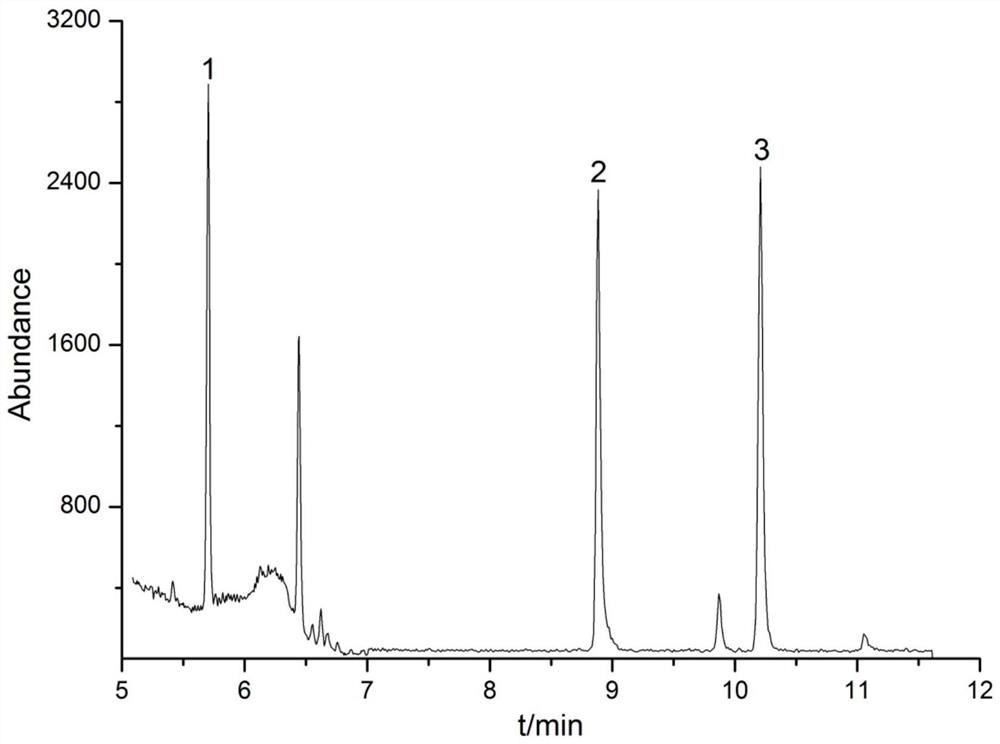A gas chromatography-mass spectrometry method for the determination of three trace polyhalogenated phenols in textiles
A technology of halogenated phenol and gas chromatography, which is applied in the field of analysis and detection of harmful trace substances, and achieves the effect of simple operation steps
- Summary
- Abstract
- Description
- Claims
- Application Information
AI Technical Summary
Problems solved by technology
Method used
Image
Examples
Embodiment 1
[0077] In Example 1, cotton cloth is used as the sample matrix to carry out standard addition recovery experiments to verify the feasibility of the method of the present invention. The cotton cloth comes from the sample submitted for inspection, and is processed according to the following steps:
[0078] (1) Extraction and adsorption of compounds: Cut cotton samples into 0.5cm╳0.5cm size, seal them for storage, weigh 1.00g of samples in 50mL plastic centrifuge tubes with stoppers, and add 5.00mL of them to each For three compound standard solutions of 10.0μg / L, 20.0μg / L and 200.0μg / L, three levels of six-parallel spiked samples were prepared, and then 1.0mL of 0.1% formic acid was added for infiltration, and 20mL of ethyl acetate was added , vortex, ultrasonically extract for 15min, centrifuge, and take the supernatant to another centrifuge tube with a stopper, extract once again, combine the upper layer extract; and add 0.20g of p-aminobenzenesulfonate-magnesium aluminum water...
Embodiment 2
[0087] In Example 2, the cotton and linen blended fabric is used as the sample matrix to carry out the standard recovery experiment to verify the feasibility of the method of the present invention. The cotton fabric comes from the sample submitted for inspection, and is processed according to the following steps:
[0088] (1) Extraction and adsorption of compounds: cut the cotton-linen blended fabric sample into 0.5cm╳0.5cm size, seal it for storage, weigh 1.00g sample each in a 50mL plastic centrifuge tube with stopper, and add 5.00 Three compound standard solutions with mL concentrations of 10.0 μg / L, 20.0 μg / L and 200.0 μg / L were prepared to obtain three-level six-parallel spiked samples, and then 1.0 mL of 0.1% formic acid was added for infiltration, and 20 mL of Ethyl acetate, vortex, ultrasonic extraction for 15min, centrifugation, and take the supernatant to another plugged centrifuge tube, re-extract once, combine the upper layer extract; and add 0.20g of p-aminobenzene...
PUM
| Property | Measurement | Unit |
|---|---|---|
| pore size | aaaaa | aaaaa |
Abstract
Description
Claims
Application Information
 Login to View More
Login to View More - R&D
- Intellectual Property
- Life Sciences
- Materials
- Tech Scout
- Unparalleled Data Quality
- Higher Quality Content
- 60% Fewer Hallucinations
Browse by: Latest US Patents, China's latest patents, Technical Efficacy Thesaurus, Application Domain, Technology Topic, Popular Technical Reports.
© 2025 PatSnap. All rights reserved.Legal|Privacy policy|Modern Slavery Act Transparency Statement|Sitemap|About US| Contact US: help@patsnap.com



